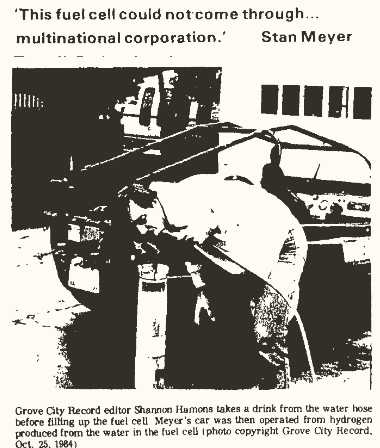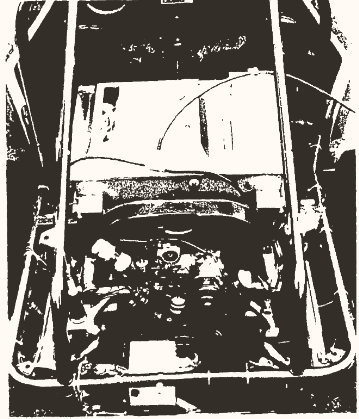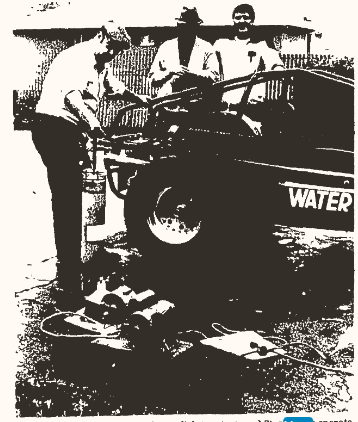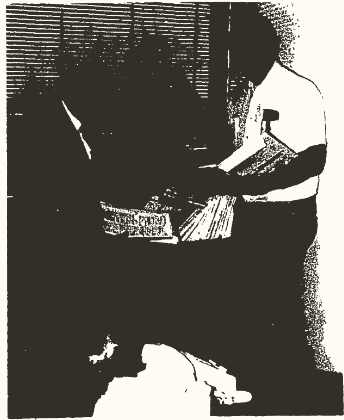Local man solves energy problem!
Operates car that runs on natural water.
By Shannon Hamons
Copyright Grove City Record
Thursday, October 25, 1984
Through the ages, men have dreamed of inventing miraculous machines for the betterment of mankind. Some have succeeded, and some have not. But one Grove City man may have the greatest invention of them all—the "Water Fuel Cell."
Stan Meyer appears to have the answer for the most difficult question ever asked: What will the human race do to overcome the depletion of its energy supplies? His answer: Extract hydrogen from water to be used as fuel.
The only difference between Stan Meyer and the people who have had the same response is that Meyer has found a way to get the powerful, plentiful hydrogen out of water easily, inexpensively, and safely. Something that before now, was impossible to do with current technology.
Meyer has been working nine years to develop the Water Fuel Cell, which can convert any type of natural water (including salt water) into a useable hydrogen gas capable of supplying all industrial, commercial, and domestic fuel needs. This means his fuel cell could operate your car, heat and cool your home, and keep the factories humming, just with simple water.
This incredible feat is possible because he has solved four major technical problems, where even scientists from the National Aeronautics Space Administration (NASA) had failed. He has taught scientists to extract hydrogen from water efficiently. Three of his inventions are: how to control the release of hydrogen, how to adjust gas output to match energy needs to the depletion of fossil fuels, and how to distribute the gas safely.
Extracting hydrogen from water is not a new idea. High school students have done it in chemistry labs all over the world. But because of the four problems listed by NASA, it was not feasible to repeat the process on a greater scale for fuel manufacturing.
But Meyer has broken away from the traditional method of hydrogen gas production—the process of electrolysis, which basically uses chemicals in the splitting of water molecules into hydrogen and oxygen. The chemical electrolysis process requires more energy to initiate and carry out than the amount of energy produced.
However, Meyer’s Water Fuel Cell operates on a physical process that polarizes the water molecules and breaks them down into hydrogen and oxygen extremely easily.
He is able to do this because his invention restricts the amount of amps of electricity (which is power consumption) flowing to the fuel cell and allows voltage (or potential energy) to take over and excite and polarize the water molecules. That in turn produces hydrogen gas with almost no energy consumption in the process.
"It is a non-chemical device that does not create energy," the self-styled inventor said. "The only thing the fuel cell does is utilize a very low energy source to release a fantastic amount of energy in the form of hydrogen gas."
"We have the technology to convert a gallon of water to a second into hydrogen. One gallon of water is equivalent to over 44,000 BTUs of energy (British thermal units) per hour. The fuel cell could operate a truck on water for over 1000 miles at 55 miles per hour. It can do all this for about 2 cents per gallon of water."
"You would need to convert about a half gallon of water per hour to run your car down the road at 55 miles per hour. The release of 44,000 BTUs is such a tremendous amount of energy, it is enough to propel the largest aircraft carrier or fly the largest airliner."
Basically, Meyer’s fuel cell is so radical and so different from every other process, that it contradicts all existing beliefs of hydrogen production. In short, it is the opposite of everything scientists say is "possible" to do.
But Meyer has demonstrated his water fuel cell to the public at fairs and at meetings and has proven how easily it can be done. Using his simple, clean, tubular fuel cell and plain tap water, he has produced a flame of over 2,500 degrees.
He has also operated the engine of an automobile on hydrogen alone—his "Water Powered Car." This standard Volkswagen engine had no ordinary modifications, except for the addition of hydrogen injectors. According to the prior state of the art process, the electrolysis process, this was impossible to do because the engine would eventually seize up from the extreme temperatures (hydrogen is three times more combustible than gasoline).
But by cleverly recirculating exhaust from the combustion back into the injectors, the hydrogen burned to co-equal the burning of gasoline. Also, since the process is working off a very small amount of amps, the production of energy increased significantly, thereby decreasing gasoline usage by over 50%.
Meyer’s engine does not need hydrogen gas in order to work, as hydrogen gas is only produced as fast as it is consumed. There is no danger resulting from the build-up of excess hydrogen. If an automobile fitted with the fuel cell ruptured, all the fuel would spill onto the roadway and would turn to water that could be safely lapped up by the EPA!
Some other regulations surpassed by the fuel cell are bypassed as well. For instance, The Environmental Protection Agency (EPA) has exempted the water-powered car from the water vapor, which is simply a water vapor. So, in effect, every time a person installs a fuel cell on a car, plane, or boat, the air and the engine is cleaned.
Naturally, some people will ask, "How are we to get more water when we face water shortages now, won’t this deplete our reserves further?"
Since emissions from the operation of the fuel cell is water vapor, the natural process of the earth’s water cycle is not degenerated—except maybe helped along. Also, any type of water can be used. The salt water from oceans is even better to use because energy will be so abundant that even sea water will be transformed into fresh drinking water.
Because energy will be so abundant that even sea water will be transformed into fresh drinking water.
Because even sea water is predicted now by desert dwellers as meaning food supply. We have less than a 30-day food supply line in this country, and after people start digesting water, they start thinking about water and food.
But before any of that happens, we would be in a war to make sure the oil supply would not be shut off to begin with. With all that is going on in the mid-east, this is the right time for the water fuel cell."
Meyer said this was a religious person when he became the religious person when he developed the invention. The U.S. was in, he went to his office research laboratory and asked God to help him put a proper supply in the country. After he did, he relied on faith and direction.
At that time, he was a corporate entrepreneur, a multi-million dollar a year truck part distributing company. He was also involved in research, development, engineering, and product design. Basically, he was a corporate entrepreneur involved in all the steps of manufacturing.
However, he depleted his financial resources trying to obtain federal and state research development funds without the risk of patent buyout. But he continued his project on faith, trying to bring his fuel cell into the economy without foreign controls or intervention. Soon afterward, he struck a deal that put two of his last three dollars into the collection plate—keeping one dollar for his evening meal of cheeseburgers.
He said that same evening, his dinner was bought by a man curious about the fuel cell! The next day another man gave Meyer $2,000 with no strings attached. That first donation led to many more by other businessmen concerned about the economic future of the country and Meyer’s fuel cell.
For nine years, the inventor said he never worried about the source of capital for his project. "There are hundreds of men with inventions who feel the same way I did and are willing to help finance a project to get an inventor on his feet."
Although he has some backers, he personally owns all the patents and is responsible to no one else. He said that is the only way this current project can get into the current production stages.
"This fuel cell could not have come through a government or a multinational corporation," he said. "Companies and governments have ways of suppressing these types of things. It had to come through a person who was determined to see the project to the light of day."
He said some big names are sums of money being offered by various foreign governments to the start of the project. He said organizations have tried to buy stock to gain their advantage since the invention was started.
"But no one really fully understands what I was up to until it was too late because I patented what seemed to be minute inventions one after the other. It was unclear what they were for until the whole picture came together."
Meyer calls himself a businessman rather than an inventor and does seem to have a savvy of the business world’s way of operating. So in order to make sure his invention would roll out for the broadest of consumers, he set down five rules for himself when the project began.
|
This is a top view of the water powered car. The powerplant is a standard Volkswagen engine with no modifications except for the hydrogen injectors. Notice the pre-production EPG system directly behind the seats (photo by Shannon Hamons, Copyright Grove City Record, Oct. 25, 1984) |
Charlie Holbrook (left), Stan Graumlich (center), and Stan Meyer operate the car on hydrogen from the water in the water fuel cell. Holbrook increased and decreased RPMs simply by adjusting the valve on the water fuel cell (photo by Shannon Hamons, Copyright Grove City Record, Oct. 25, 1984) |
Patent attorney Tony Cenanruno and Stan Meyer examine some of the 30 plus patents issued to Meyer. Cenanruno was instrumental in assuring the "pioneer" patents were protected from outside interests (photo by Shannon Hamons, Copyright Grove City Record, Oct. 25, 1984) |




